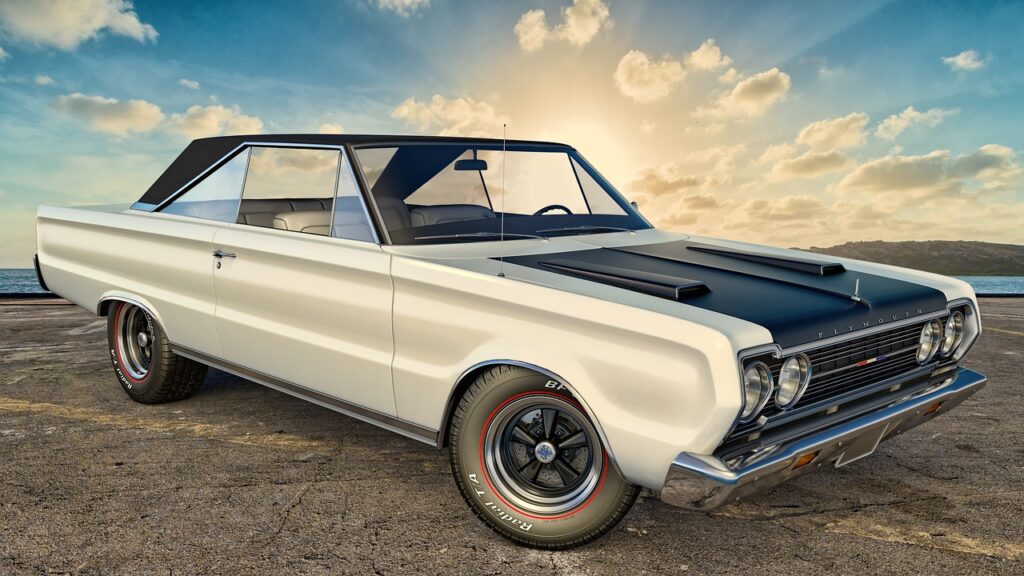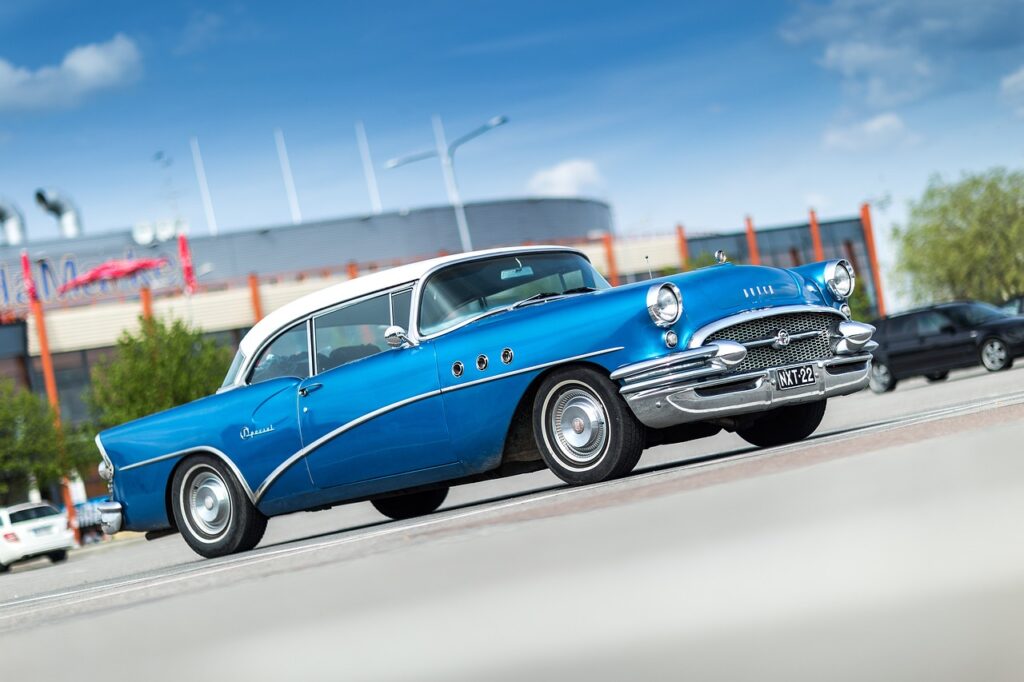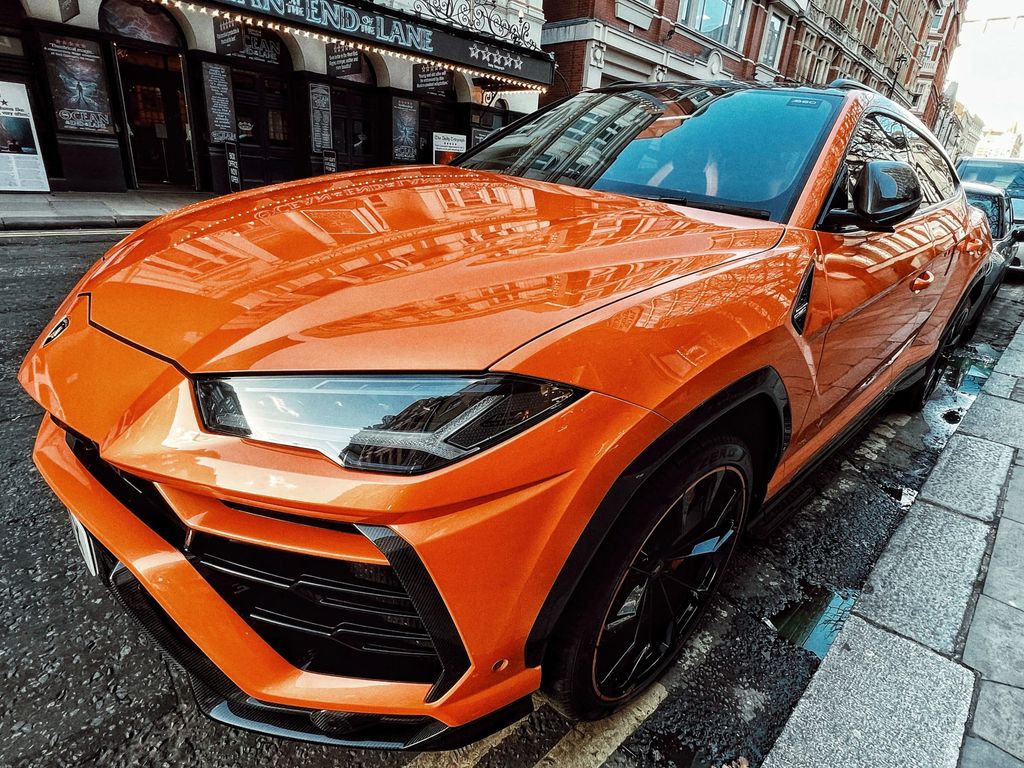Generational shifts, as we all know, are absolute chaos magnets for accepted pop-culture wisdom. One moment something’s the bee’s knees, the next it’s a relic gathering dust in the attic of collective memory. And while music, movies, and fashion might snap back quickly, the automotive world, bless its mechanical heart, often lags a beat or two behind when it comes to truly recognizing its past glories. Old cars, from a purely clinical standpoint, are often just consumer products past their prime, destined for the crusher or an endless cycle of costly repairs.
But let’s be real, for us gearheads, it’s never just clinical, is it? Vehicles are tangled up with our emotions, our memories, and entire eras of our lives. Whether it was that clunky first beater that smelled faintly of stale fries and freedom, the poster car plastered on our childhood bedroom wall, the ride in which you first saw *that* person, or the trusty family hauler that endured countless soccer practices, we forge subconscious bonds with these machines that run deep, especially if you’ve got motor oil in your veins. It’s a connection that transcends mere transportation, becoming a part of our personal histories.
Right now, the collector car world is in a fascinating state of flux, deep in a phase of introspection. The old guard’s rigid definitions of “classic” are being challenged, not by polite suggestion, but by a fresh wave of drivers who are absolutely champing at the bit to own a completely different set of vehicles, pulled directly from their own cultural past. As the previous stalwarts of the high-dollar auction scene – you know, the muscle cars, the ’30s to ’50s hot rods, and those pre-war beauties – slowly recede from the collective zeitgeist, a rising tide of previously underappreciated autos are poised to finally have their moment in the sun.
What exactly qualifies a car as “underappreciated” in this brave new world? Well, these are the models that, for the most part, got the cold shoulder from the Boomer-fueled industry surrounding collector vehicles. They often fell outside that narrow, almost suffocating definition of what was considered desirable, maybe because of their performance, their vintage, their styling, or even their country of origin. But with today’s car fans finally ditching the “American-made or bust” mentality, embracing trucks and SUVs as legitimate cool, and openly welcoming metal from the gloriously quirky Malaise (mid-’70s to early ’80s) and Rad (’80s to ’90s) periods, the floodgates have opened. So, let’s fire up the memory banks, crack open a cold one, and take a joyride through 14 of the most criminally overlooked cars ever to grace the road. You just might find your next garage project right here. You’re welcome.
***
### The Unsung Heroes: Kicking Off Our Tour of Automotive Brilliance

1. **Berkeley T60: Britain’s Motorcycle-Powered Oddity** Imagine cruising in 1959, getting sports car thrills for about 500 bucks. Sounds like a fantasy, right? That was the reality delivered by Charles Panter and Laurie Bond’s Berkeley T60 microcar. This wasn’t some cobbled-together contraption; it was a testament to innovative thinking, proving definitively that budget limitations could be overcome with clever engineering and a dash of audacity. The T60 wasn’t just cheap; it was a genuinely smart piece of design that challenged the status quo of what a “sports car” could be.
Its lightweight fiberglass construction was a revelation, enabling remarkable efficiency even with its tiny dimensions. Don’t let its size fool you; beneath that minimalist exterior lay sophisticated engineering solutions designed to maximize every ounce of performance from its motorcycle-derived powerplant. Efficiency wasn’t just a buzzword; it was baked into the T60’s DNA, with aerodynamic shapes that prioritized function over conventional aesthetics. This approach gave it a unique, almost futuristic, look that set it apart from its contemporaries.
Powering this pint-sized marvel were Excelsior Talisman two-stroke engines, delivering surprisingly sprightly performance. With a total vehicle weight hovering between 680-725 pounds, these engines enabled impressive acceleration, turning everyday drives into genuine adventures. The minimalist cockpit was all about driving purity, with essential controls positioned within easy reach and simplified instrumentation providing only the necessary information. Every design decision, down to the last nut and bolt, was influenced by the relentless pursuit of weight savings, making it a true featherweight champion.
Berkeley wasn’t just building cars; they were pioneering grassroots engineering innovation that would go on to inspire countless later kit car movements. They showed that you didn’t need a massive factory or an endless budget to create something genuinely exciting and forward-thinking. Today, surviving examples of the Berkeley T60 are highly sought after by collectors who appreciate its unique blend of efficiency, character, and sheer ingenuity. It’s a car that proves great things truly do come in small packages, especially when those packages are packed with smart design.

2. **Jowett Jupiter: Post-War Innovation When Britain Needed Hope** In the austere landscape of post-war Britain, where rebuilding efforts were paramount, the Jowett Jupiter emerged as a beacon of automotive innovation and, frankly, a much-needed dose of hope. Engineered by the brilliant Dr. Robert Eberan von Eberhorst, this car was a marvel of advanced construction, featuring a lightweight aluminum body meticulously crafted over a robust tubular steel chassis. This wasn’t just about looking good; the clean aerodynamic lines and the strategic use of lightweight materials ensured optimal weight distribution, laying the groundwork for competitive performance on the track.
Beneath its sleek bonnet lay a 1,486cc flat-4 engine, producing a modest but effective 60-63 horsepower. While those numbers might not drop jaws today, in the context of its lightweight design, this power translated into truly impressive track performance. The Jupiter wasn’t a brute; it was a dancer, gracefully navigating corners and holding its own against more powerful rivals, a testament to its superb engineering. It proved that intelligent design could triumph over sheer horsepower, a lesson many still need to learn.
The purposeful cockpits of the Jupiter perfectly balanced comfort with the demands of sporting requirements. Essential instrumentation was comprehensive, including detailed engine monitoring systems, while adjustable seating ensured various driver sizes could find their sweet spot. Thoughtful design attention even extended to practical storage solutions, highlighting that this was a car built for real-world usage, not just show. It was a driver’s car through and through, designed for engagement and performance.
The Jupiter’s sporting credentials were emphatically established with class wins at the legendary Le Mans in 1950, 1951, and 1952. These victories weren’t flukes; they were a consistent demonstration of its inherent capability and reliability under extreme pressure. With only 50% of the original 899 Jupiters surviving today, preservation examples are particularly valuable, commanding average market values around $35,000, with exceptional units fetching up to $58,000 from international collectors who recognize and appreciate its rich racing heritage and innovative design.
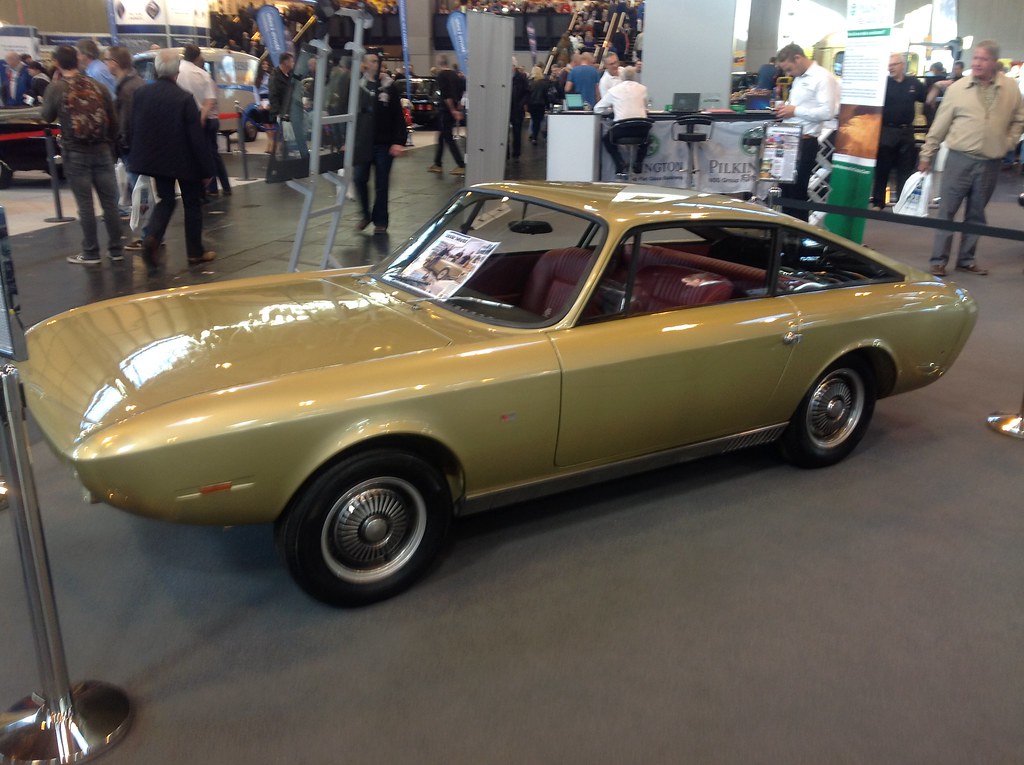
3. **TVR Tina: The Hot Hatch That Never Was** Imagine a world where the hot hatch arrived years, even decades, before mainstream manufacturers even recognized the opportunity. That world almost existed, thanks to the TVR Tina. This compact sports car prototype was the brainchild of Martin Lilley, born from a collaboration with the visionary Trevor Fiore. Based on humble Hillman Imp mechanicals, the Tina was a groundbreaking concept that truly predicted the future of compact, performance-oriented vehicles. It was a glimpse into what could have been, a genuine pioneer ahead of its time.
The Tina’s compact dimensions weren’t a limitation; they were a core strength, emphasizing agility and nimble handling over brute force. Its modern design language was remarkably forward-thinking, strongly suggesting future automotive directions with its clean lines and purposeful stance. TVR clearly understood that sometimes less is more, especially when it comes to creating an engaging driving experience. They designed it with flexibility in mind, offering both a convertible “Spider” and a fixed-roof coupe configuration, providing market versatility that could have appealed to a wide range of buyers.
Under the hood, an 875cc inline-4 engine produced a respectable 51 bhp, enabling the Tina to achieve top speeds of 160 km/h. What’s more, it delivered an impressive 8.1 L/100 km fuel economy, a testament to its lightweight construction and efficient design. This wasn’t a gas-guzzling monster; it was a smart, economical performer. The interior showcased efficient packaging, maximizing interior space within its modest external dimensions. Practical layouts and simple control systems prioritized reliability over complexity, making it an easy car to live with.
Had production commenced, the TVR Tina could have single-handedly created and defined the hot hatch market years before the Volkswagen Golf GTI ever graced European roads. It represents one of those tantalizing “what if” moments in automotive history, a car that possessed all the ingredients for success but, for reasons unknown, never got its chance to shine. Today, it remains a fascinating footnote, a testament to a brilliant idea that was simply too far ahead of its time, leaving enthusiasts to dream of the nimble, fun-to-drive machine it could have been.

4. **Lister Storm: The V12 Sledgehammer** While McLaren F1s were capturing headlines and dominating conversations in the 1990s, Lister was quietly, almost defiantly, developing its own brand of supercar: the Storm. This wasn’t about sophisticated finesse or technological wizardry that would grace the covers of glossy magazines. No, the Lister Storm was a beast of a different stripe, prioritizing unadulterated brute force and raw power over any pretense of refinement. It was, quite literally, a sledgehammer on wheels, built for one purpose: to go fast, relentlessly.
Its aggressive proportions weren’t accidental; they screamed raw performance from every angle. The design emphasized function, with a no-nonsense aesthetic that conveyed its serious intentions. Beneath that intimidating exterior, the Storm featured carbon fiber bodywork seamlessly integrated over a carbon fiber chassis, providing optimal structural integrity and keeping weight in check as much as possible for such a massive machine. Functional aerodynamics further enhanced high-speed stability, ensuring that this beast remained somewhat controllable when unleashed on the open road or track.
At the heart of the Storm was a truly monstrous 6,996cc V12 engine. This colossal powerplant produced an astounding 585-594 horsepower and an equally impressive 580 lb-ft of torque. Despite weighing a hefty 3,670 pounds, this immense power enabled the Storm to achieve 0-60 mph acceleration in a blistering 4.1 seconds. These were numbers that put it squarely in supercar territory, challenging the established order with sheer, unadulterated displacement and a relentless surge of power.
The cockpit, as you might expect, was racing-inspired and laser-focused on driver concentration. Essential instrumentation provided only the most critical performance data, while racing-derived seating maintained occupant security during extreme driving maneuvers. Spartan layouts mirrored the car’s pure performance priorities; there were no unnecessary frills or distractions here. The Lister Storm exemplified British engineering at its most excessive, a glorious middle finger to the notion that sophistication was the only path to speed, proving instead that when properly applied, displacement could indeed substitute for nearly everything else.

5. **Alpine M64: The French Giant-Killer** In 1964, Jean Redele’s Alpine M64 made an almost unthinkable statement: intelligence and aerodynamic efficiency could triumph over sheer engine displacement. Weighing in at a mere 1,428 pounds, this French marvel achieved remarkable performance, not through a massive engine, but through an obsessive focus on aerodynamic purity. Only three examples of this exquisite machine were ever built, making it an incredibly rare and significant piece of automotive history. Its existence was a masterclass in proving that thoughtful engineering could humble giants.
Measuring a svelte 167.3 inches long, 64.6 inches wide, and just 42.1 inches tall, the M64’s proportions were meticulously optimized to minimize drag coefficients. Its smooth, uninterrupted surfaces were a direct result of this aerodynamic imperative, creating a shape that sliced through the air with incredible ease. This wasn’t just about looking good; it was about scientific precision applied to automotive design. Every curve, every line, served a functional purpose, making the M64 a rolling testament to the power of thoughtful design.
Despite being powered by a tiny 1.1L engine that produced a modest 115 horsepower, the exceptional aerodynamic development of the M64 allowed it to achieve truly astounding speeds of 168 mph. Think about that for a moment: a 1.1-liter engine pushing a car to nearly 170 mph. This wasn’t magic; it was the embodiment of French engineering philosophy, where clever solutions and intelligent design consistently triumphed over the simple, brute-force approach of larger displacements. It was an intellectual victory, proving brain over brawn.
The M64’s cockpit was, unsurprisingly, competition-focused, with every element geared towards weight reduction and driver efficiency. Essential instrumentation provided only the necessary performance data, and racing-derived seating kept the occupant securely planted during high-speed maneuvers. A five-speed transmission further maximized engine efficiency, allowing the driver to extract every last drop of performance. The M64 established lightweight construction principles that continue to influence Alpine’s modern revival, standing today as a pinnacle of efficient performance engineering and a stark reminder that true brilliance often lies in doing more with less.
6. **Chrysler Newport (1977): The Last Stand of American Excess** In 1977, as America grappled with a burgeoning fuel crisis and a push towards automotive downsizing, the Chrysler Newport stood as a magnificent, almost defiant, monument to cultural resistance. It wasn’t just a car; it was a statement, maintaining traditional luxury car values and massive proportions on the venerable C-body platform. While other manufacturers were shrinking their offerings, Chrysler dug in its heels, offering a final, glorious hurrah to the era of vast, comfortable American land yachts. It was a battleship amidst a growing fleet of cruisers.
The Newport’s sheer scale was breathtaking. Measuring a colossal 226.6 inches long and 79.7 inches wide, it absolutely dominated contemporary automotive landscapes. Its formal rooflines and substantial chrome applications weren’t just styling cues; they were badges of honor, signaling an unapologetic commitment to the kind of opulence and road presence that was quickly becoming a relic of the past. This car didn’t whisper; it roared its presence, demanding attention on every street it graced.
Under the hood, the optional 440 cubic inch V8 engine produced a robust 195 horsepower and 320 lb-ft of torque. This was a remarkable achievement, particularly during a period when emissions regulations were tightening their grip and choking performance out of many other engines. The Newport’s powerplant represented an impressive feat of engineering, maintaining a significant level of muscle despite the restrictive performance climate of the era. It was a last bastion of V8 glory in a world rapidly moving towards efficiency.
Inside, spacious accommodations unequivocally prioritized passenger comfort over any efficiency considerations. This was a car designed for luxurious travel, not for setting lap records or winning fuel economy awards. Traditional luxury appointments abounded, including comprehensive instrumentation and premium materials used throughout the cabin. Crucially, its seating arrangements provided genuine six-passenger capacity, making it a true family hauler for the affluent. As the final generation of full-size American luxury cars, the 1977 Newports hold a historical significance that transcends mere transportation utility. Pristine examples are now experiencing increasing collector attention, as enthusiasts recognize its role as the magnificent end of an era.
Car Model Information: 1967 Chrysler Newport
Name: Chrysler Newport
Caption: 1962 Chrysler Newport hardtop coupe
Manufacturer: Chrysler (division)
Class: Full-size car
Production: 1940–1941,1949–1950,1960–1981
Layout: FR layout
Predecessor: DeSoto (automobile),Chrysler Windsor
Successor: Chrysler New Yorker,Chrysler Fifth Avenue
Categories: 1960s cars, 1970s cars, 1980s cars, All articles with unsourced statements, Articles with short description
Summary: The Newport was a name used by Chrysler for both a hardtop body designation and also for its lowest priced model between 1961 and 1981. Chrysler first used the Newport name on a 1940 show car, of which five vehicles were produced. From 1950 to 1956, the Newport name was then used to designate any Chrysler model with a hardtop body style (for example, the 1956 Chrysler “New Yorker 2 Door Newport”). In 1961, Chrysler introduced the Newport as a new, low-priced model, offering large, comfortable two- and four-door Chrysler models that were modestly priced compared with the Chrysler 300, the Chrysler New Yorker and the Imperial. For 1961, the Newport was priced below the Chrysler Windsor (which originally replaced the Chrysler Royal) in the Windsor’s final year.
Get more information about: Chrysler Newport
Buying a high-performing used car >>>
Brand: Chrysler Model: Newport
Price: $18,000 Mileage: 85,541 mi.

7. **Prince Skyline Sport: The Grandfather of Godzilla** Before the legendary GT-R lineage became known as “Godzilla,” there was another, more elegant ancestor that laid the groundwork for its sophisticated performance: the Prince Skyline Sport. This magnificent machine was born from a visionary partnership between Prince Motor Company and the iconic Italian designer Giovanni Michelotti. The result was a sophisticated GT design that not only elevated Japanese automotive standards but also established aesthetic principles that would be inherited by its formidable descendants. It was a fusion of Japanese engineering and Italian flair.
Michelotti’s Italian styling sophistication transformed the humble Gloria chassis into genuinely exotic proportions. The car exuded an aura of class and performance that was unlike anything else coming out of Japan at the time. To cater to diverse tastes and needs, Prince offered both coupe and convertible configurations, providing market variety within what was an ultra-limited production run. This exclusivity only added to its allure, making it a coveted item for Japan’s discerning elite.
Power came from a 1.9L inline-4 engine, producing a respectable 94 horsepower. While these numbers might seem modest by today’s standards, they were more than sufficient to propel the elegant GT with grace and authority. Original pricing for the coupes reached an eye-watering $15,400, effectively restricting ownership to Japan’s most affluent individuals. This price tag wasn’t just for performance; it was for an unparalleled blend of luxury, exclusivity, and groundbreaking design.
Inside, the luxurious appointments more than justified its premium pricing strategy. Comprehensive instrumentation displayed serious performance intentions, letting the driver know this was more than just a pretty face, while comfortable seating accommodated both touring and sporting requirements with equal aplomb. Today, surviving Skyline Sports regularly achieve six-figure auction results, unequivocally confirming its foundational importance to the GT-R heritage. With only 60 units ever produced, each surviving example is exceptionally valuable, a tangible link to the beginnings of a legend and a prime example of an underappreciated pioneer.
Alright gearheads, buckle up because our joyride through automotive history isn’t over yet! We’ve already peeled back the layers on seven truly spectacular machines that, frankly, deserved way more credit than they ever got. But hold onto your lug nuts, because we’re diving even deeper, unearthing more forgotten gems that prove brilliance doesn’t always come with a massive marketing budget or a household name. These are the cars that whispered genius when others were shouting, leaving a legacy of innovation, daring design, and sometimes, a frustrating ‘what if.’ It’s time to spotlight seven more distinct characters that offer today’s discerning collectors something truly special.
***
Car Model Information: 2020 Hyundai PALISADE Limited
Name: Nissan Skyline
Caption: 2019 Nissan Skyline Hybrid GT Type SP (HV37, Japan)
Manufacturer: unbulleted list
Aka: unbulleted list
Production: 1957–present
Class: unbulleted list
Layout: unbulleted list
Related: unbulleted list
Predecessor: Prince Sedan
Categories: 1960s cars, 1970s cars, 1980s cars, 1990s cars, 2010s cars
Summary: The Nissan Skyline (Japanese: 日産・スカイライン, Hepburn: Nissan Sukairain) is a brand of automobile originally produced by the Prince Motor Company starting in 1957, and then by Nissan after the two companies merged in 1967. After the merger, the Skyline and its larger counterpart, the Nissan Gloria, were sold in Japan at dealership sales channels called Nissan Prince Shop.
The Skyline was largely designed and engineered by Shinichiro Sakurai from inception, and he remained a chief influence of the car until his death in 2011.
Skylines are available in either coupé, or sedan body styles, plus station wagon, crossover, convertible and pickup/sedan delivery body styles. The later models are most commonly known by their trademark round brake and tail lights. The majority of Skyline models are rear-wheel drive, with part-time all-wheel drive being available since the debut of the eighth-generation Skyline (R32).
While not distributed in the United States until its importation as the Infiniti G-series in the early 2000s (the first generation Prince Skyline was imported, but sold poorly), the Skyline’s prominence (particularly for the GT-R variant) in video games, movies and magazines resulted in many such cars being brought in as grey import vehicles there, and makes up a large amount of second-hand Japanese car imports to Europe and North America.
Starting with the third-generation Skyline (C10) and up to the tenth-generation Skyline (R34), the chassis, suspension and some of the engines were shared with the luxury-oriented longer wheelbase Nissan Laurel. When the former Prince factory at Musashimurayama closed in 2002 (coinciding with the discontinuation of the Laurel that same year), the Skyline used the then-new FM platform that was shared with the 350Z starting with the eleventh-generation Skyline (V35).
The eleventh-generation Skyline (V35) was another major turning point for the nameplate, as it dropped some of the previous generation Skyline’s trademark characteristics such as the straight-six engine (replaced with a V6) and turbocharging (reintroduced in the thirteenth-generation/V37 model), and eventually separated the GT-R into its own line. Nissan decided to retain the Skyline for the luxury-sport market segment formerly held by the Laurel, while its platform-mate, the 350Z, revived the Z line of pure sports cars. The V35 was the first Skyline made for export to North America, being sold under Nissan’s luxury marque Infiniti as the G35 in 2002. The Skyline (V36/J50) is sold in Europe, North America, South Korea, Taiwan, and the Middle East as the Infiniti G37 and EX respectively.
As of 2024, the Skyline is the only remaining sedan in Nissan’s Japanese lineup following the discontinuation of both the Fuga and Cima in 2022.
Get more information about: Nissan Skyline
Buying a high-performing used car >>>
Brand: Prince Model: Skyline Sport
Price: $24,987 Mileage: 84,683 mi.
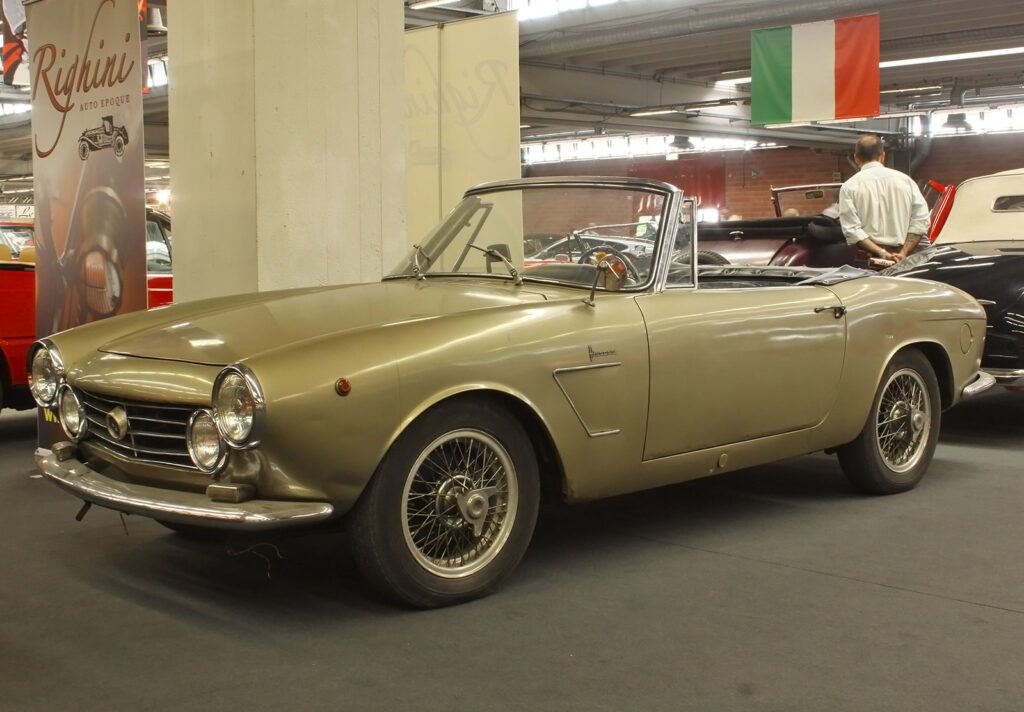
8. **Osca 1600 GT: When the Maserati Brothers Went Independent** Imagine leaving a name like Maserati behind to pursue something even more personal, more uncompromising. That’s exactly what the legendary Maserati brothers did when they founded Osca, driven by an unyielding desire for pure sports car development. These weren’t mass-produced machines; they were bespoke works of art, lovingly crafted by legendary artisans at Zagato, Fissore, and Touring. Each Osca 1600 GT was a testament to individual craftsmanship, a physical manifestation of passion that rejected the compromises of larger-scale manufacturing.
Underneath those gorgeous, hand-formed bodies, you’d find a robust tubular steel chassis, providing a fantastic foundation for the spirited driving experience. Power came from a potent 1,568cc twin-cam four-cylinder engine, capable of kicking out anywhere from 95 to a scorching 140 horsepower depending on its specific tune. While those numbers might not make your smartphone sweat today, remember, this was a lightweight Italian exotic designed for precision, not just brute force. It was about connection, about feeling every single revolution, every turn.
And speaking of connection, the cockpit of the Osca 1600 GT was pure racing inspiration, meticulously favoring driver involvement over plush passenger comfort. Essential controls were perfectly positioned, practically an extension of your own limbs, while comprehensive instrumentation kept you clued into every mechanical heartbeat. The spartan layout wasn’t an oversight; it was a deliberate choice, mirroring the car’s serious performance intentions. This wasn’t a cruiser; it was a focused tool for driving enjoyment.
The rarity of the Osca 1600 GT is a story in itself, with a mere 128 examples ever built between 1960 and 1963. That’s not just rare; that’s practically a unicorn with Italian flair. Today, these beautiful machines are finally getting their due. Current auction values for similar Italian exotics might average around $139,142, but authentic Osca examples, with their undeniable Maserati family engineering heritage, represent seriously significant investments and a growing appreciation among collectors who understand true automotive pedigree.
Car Model Information: 2020 Hyundai PALISADE Limited
Name: O.S.C.A.
Logo: OSCA badge – Flickr – exfordy.jpg
Foundation: 1947
Defunct: 1967
Fate: Ceased production
Location: San Lazzaro di Savena,Province of Bologna
Industry: Automotive
KeyPeople: Ettore Maserati,Ernesto Maserati
Products: Automobile
Categories: 24 Hours of Le Mans teams, Articles with German-language sources (de), Articles with short description, Automotive companies established in 1947, CS1 French-language sources (fr)
Summary: O.S.C.A. (Officine Specializzate Costruzione Automobili—Fratelli Maserati S.p.A.) was an Italian manufacturer of racing and sports cars established 1947 in San Lazzaro di Savena, Bologna, by the Maserati brothers, and closed down in 1967. The company name is usually written OSCA or Osca.
Get more information about: O.S.C.A.
Buying a high-performing used car >>>
Brand: Osca Model: 1600 GT
Price: $24,987 Mileage: 84,683 mi.

9. **De Tomaso Sport 5000: The Shelby-Italian Connection** When two automotive titans like Carroll Shelby and Alejandro De Tomaso decide to collaborate, you know something truly special—and probably a little unhinged—is going to happen. The De Tomaso Sport 5000 was exactly that: automotive magic in a ridiculously lightweight package. Imagine a car weighing just 1,455 pounds, with a roaring Ford V8 not just under the hood, but positioned mid-chassis as an integral structural component. That, my friends, was revolutionary engineering for 1965, a stroke of genius that few dared to attempt.
Pete Brock, a name synonymous with aerodynamic efficiency, sculpted the Sport 5000’s aluminum bodywork. The result was a stunning machine with low-slung proportions that screamed racing intentions from every angle. It wasn’t just pretty; it was functionally brilliant. Adjustable rear wings provided fine-tuning capability, hinting at the serious track performance this car was designed for, all wrapped in minimalist aesthetics that prioritized pure function over unnecessary decoration.
Inside, the Sport 5000 doubled down on its racing ethos. The cockpit was unapologetically focused on the driver, eliminating any unnecessary comfort features. Essential controls were perfectly placed for competitive driving, reinforcing the notion that this car was built for speed and precision. Every design decision, down to the last rivet, was influenced by an obsession with lightweight construction, culminating in a purposeful layout that highlighted its serious performance intentions.
Tragically, only one prototype of this incredible machine was ever completed. One. This isn’t just a missed opportunity; it’s one of automotive history’s greatest heartbreaks. The Sport 5000 was poised to combine Shelby’s unparalleled racing expertise with De Tomaso’s Italian engineering sophistication, a potent brew that could have changed the supercar landscape forever. It remains a tantalizing glimpse into what might have been, a true testament to unfulfilled potential.
Car Model Information: 2020 Hyundai PALISADE Limited
CarName: De Tomaso Sport 5000 Fantuzzi Spyder,Ghia DeTomaso,De Tomaso 70P,De Tomaso P70
Constructor: De Tomaso
Designer: Pete Brock
Team: De Tomaso
Drivers: Pierre Noblet,Franco Bernabei,Umberto Maglioli,Roberto Bussinello
Chassis: backbone chassis
FrontSuspension: Double wishbone suspension
RearSuspension: wishbone suspension
Length: 4084 mm
Abbr: on
Width: 1765 mm
Wheelbase: 2362 mm
Track: 1359 mm
EngineName: Ford Motor Company
Capacity: 289 cuin
Configuration: Overhead valve,V8 engine
EnginePosition: mid-engine
Gears: 5-speed
Type: manual transmission
Weight: 660 kg
Debut: 1966 Mugello Grand Prix
Races: 1 (3 entries)
Wins: 0
ConsChamp: 0
DriversChamp: 0
TeamsChamp: 0
Poles: 0
FastestLaps: 0
Categories: 1960s cars, Articles with short description, Automobiles with backbone chassis, De Tomaso vehicles, Rear mid-engine, rear-wheel-drive vehicles
Summary: The De Tomaso Sport 5000 (also known as the Ghia DeTomaso, the De Tomaso 70P, or the De Tomaso P70) was a short-lived sports racing car built by De Tomaso in 1965. Fitted with a 289 cu in (4,736 cc) Ford V8 engine, the Sport 5000 was initially designed to be used as a Grand Tourer; however, only one car was ever built of the planned fifty, meaning that it competed solely as a sports prototype in just one race, the 1966 World Sportscar Championship Mugello 500 km.
Get more information about: De Tomaso Sport 5000
Buying a high-performing used car >>>
Brand: De Tomaso Model: Sport 5000
Price: $24,987 Mileage: 84,683 mi.
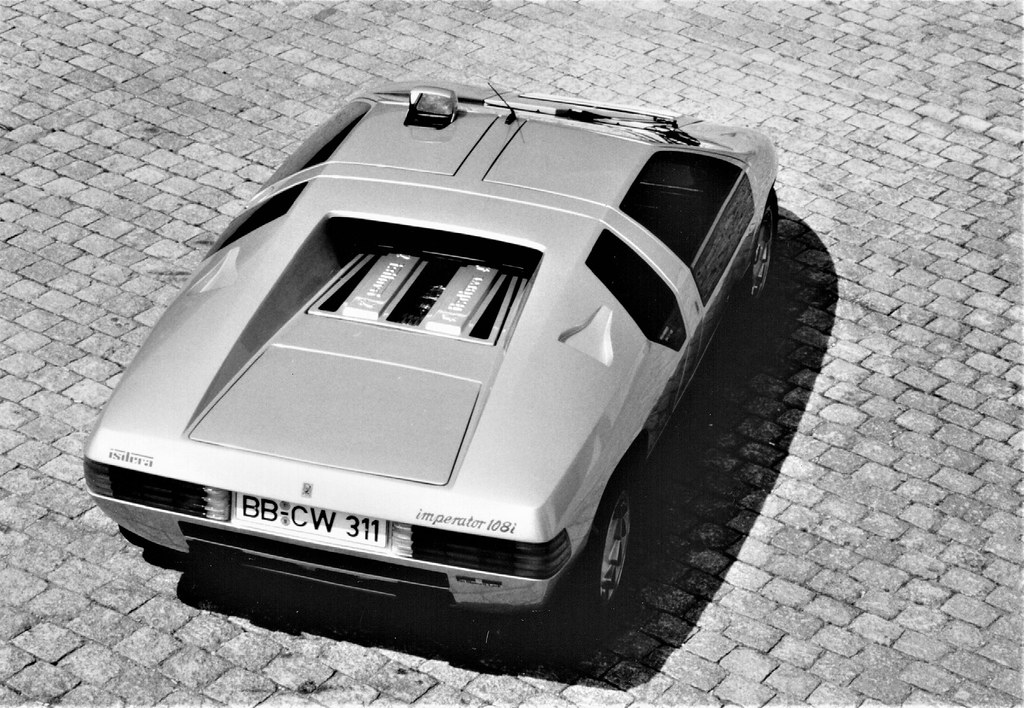
10. **Isdera Imperator 108i: Germany’s Secret Supercar** While some supercars loudly announce their arrival with fanfare and magazine covers, Eberhard Schultz’s Isdera GmbH took a different, far more clandestine path. They created the Imperator 108i, a production supercar that, despite its remarkable capabilities, remained virtually unknown outside the most dedicated enthusiast circles. This was the kind of car you’d only see if you were in the know, a stealthy missile that delivered mind-blowing performance without seeking the public’s adoration.
But make no mistake, it was impossible to ignore once you laid eyes on it. The Imperator boasted distinctive design elements that screamed exotic, from its dramatic gullwing doors that opened skyward to its truly unique roof-mounted periscope rearview mirror—a feature ripped straight from a fighter jet or a submarine, depending on your vibe. Fiberglass bodywork draped over a robust tubular steel frame provided optimal strength-to-weight ratios, while aggressive aesthetics conveyed its very serious performance intentions.
Under the rear deck, a range of formidable Mercedes-Benz V8 engines, from 5.0L to a thunderous 6.0L, churned out between 235 and a blistering 410 horsepower. Paired with a five-speed manual transmission known for its proven reliability, this powertrain delivered the kind of grunt you’d expect from a German supercar, ready to pounce at a moment’s notice. It was a potent combination of robust engineering and sheer, unadulterated power.
The cockpit was a masterclass in sophisticated design, focusing heavily on technological advancement. Comprehensive instrumentation kept the driver fully informed with detailed vehicle monitoring systems, while comfortable seating somehow managed to accommodate both long-distance touring and the demands of serious sporting requirements. The quality materials used throughout showcased impeccable German engineering standards. Today, its extreme rarity ensures exceptional exclusivity, and as appreciation for 1980s supercar designs continues to rise, so do the values of these secret German rockets.
Car Model Information: 2020 Hyundai PALISADE Limited
Name: Isdera Imperator 108i
Manufacturer: Isdera
Production: 1984–1993,30 units produced
Assembly: Leonberg
Predecessor: Isdera
Successor: Isdera Commendatore 112i
Class: Sports car
BodyStyle: coupé
Layout: Rear mid-engine, rear-wheel drive layout
Platform: Fibreglass
Engine: {{convert,5.0,L,cc,0,abbr=on,Mercedes-Benz M117 engine,V8 engine
Abbr: on
Transmission: ZF Friedrichshafen,manual transmission
Wheelbase: cvt
Length: cvt
Width: cvt
Height: cvt
Weight: 1250 kg
Related: List of Mercedes-Benz vehicles#Concept models
Designer: Eberhard Schulz
Categories: 1990s cars, Articles with short description, CS1 Finnish-language sources (fi), Cars discontinued in 1993, Cars introduced in 1984
Summary: The Isdera Imperator 108i is a low-volume German sports car produced from 1984 to 1993. The Imperator 108i was born out of the CW311 concept car from 1978, which Eberhard Schulz, who at the time worked as a design engineer for Porsche, designed in his free time, using Mercedes parts, mainly the V8 engines (Porsche had no 928 yet). Mercedes-Benz allowed the use of the Mercedes badge and name but had no interest in putting the CW311 into production, so Schulz established his own engineering company, Isdera, to produce the car under his own brand. Isdera AG owns the trademarks to Imperator as separate brand.
Get more information about: Isdera Imperator 108i
Buying a high-performing used car >>>
Brand: Isdera Model: Imperator 108i
Price: $24,987 Mileage: 84,683 mi.
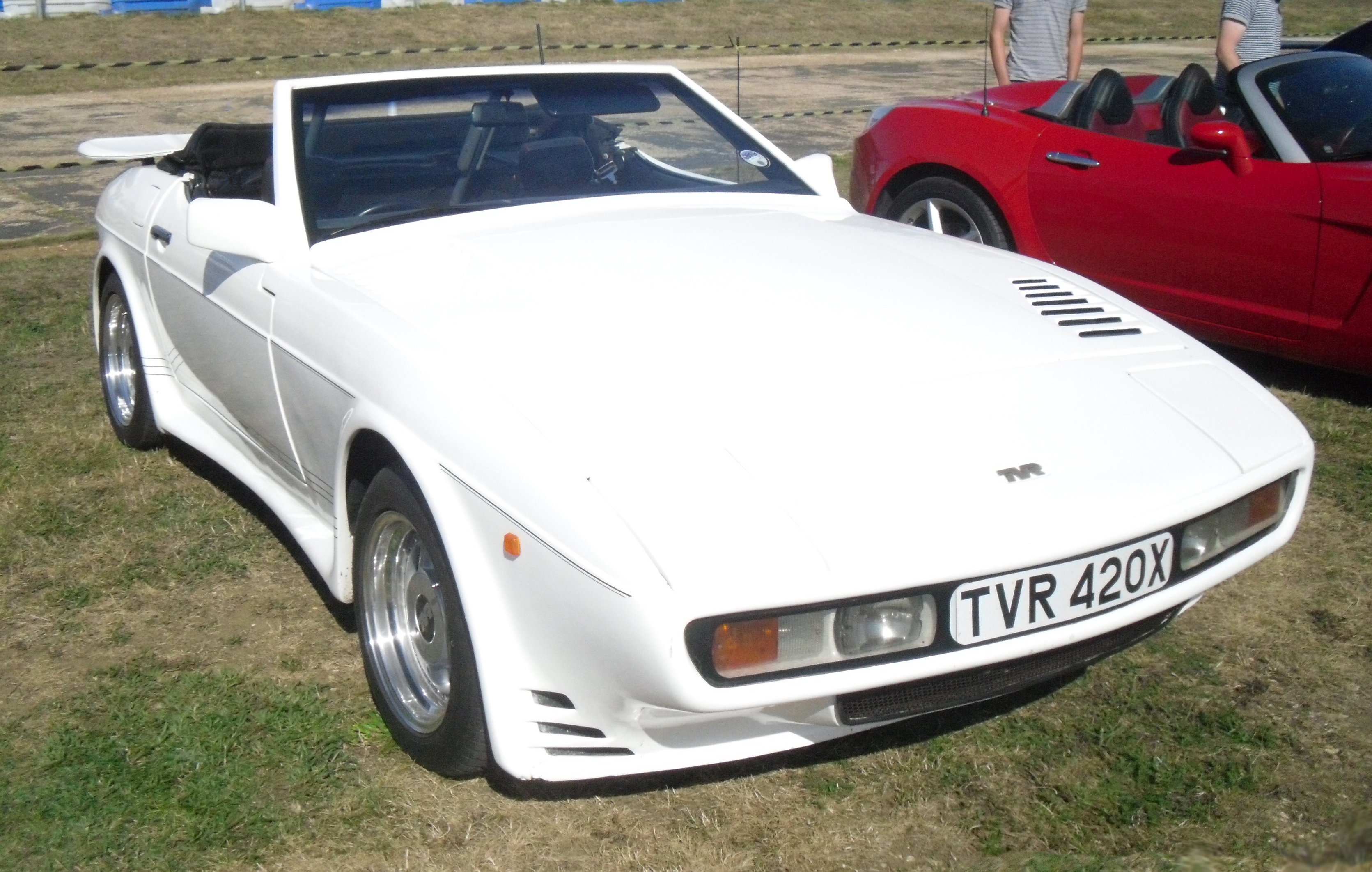
11. **TVR 420 SEAC: Britain’s Kevlar Rocket Ship** If you thought TVR was already a bit bonkers, then you clearly haven’t met the 420 SEAC. This absolute beast, conjured by Chris Schirle’s team between 1986 and 1988, wasn’t just aggressive; it was a defiant middle finger to automotive convention. It sported unprecedented Kevlar-Aramid composite bodywork over a tubular steel spaceframe, a lightweight, super-strong combination that was cutting-edge for its time. This wasn’t just a car; it was a composite-bodied, fire-breathing rocket ship.
Its aesthetics were as unapologetic as its construction. Shortened front sections with glass-covered indicators gave it a menacing glare, while widened wheel arches perfectly housed its Compomotive wheels. And that dominant rear spoiler? It wasn’t just for show; it covered the entire boot lid, making a statement about serious downforce. This car wasn’t subtle, and it didn’t try to be. It was pure, unadulterated, in-your-face performance.
Propelling this British bruiser was a 4.2L Rover V8, expertly tuned to unleash a formidable 300 horsepower. That’s enough to launch the 420 SEAC from 0 to 60 mph in a blistering 4.7 seconds, pushing it to a top speed of 266 km/h. These were supercar numbers, achieved with a distinctly British soundtrack and an almost terrifying directness. It was a visceral experience, to say the least.
The cockpit was precisely what you’d expect from a TVR of this era: spartan. Comfort features were eliminated in favor of pure driver connection, a philosophy that permeates every inch of the cabin. Original instrumentation provided essential data without any digital interference, while minimalist layouts focused your attention solely on the driving experience. Racing-derived ergonomics ensured controls were positioned for performance driving, not luxury touring. With only 37 examples ever built, these machines are exceptionally rare. Recent auctions show values between $28,000 and $44,000, a significant appreciation from their $10,000 price tag in 2010 for good examples, showing that more and more enthusiasts are recognizing the raw, untamed brilliance of this Kevlar beast.
Car Model Information: 2020 Hyundai PALISADE Limited
Name: TVR 420 SEAC
Manufacturer: TVR
Production: 1986–1988,37 produced
Assembly: Blackpool,England
Platform: TVR Wedges
Class: Sports car
BodyStyle: 2 – door drophead
Layout: FR layout
Engine: Rover V8 engine
Related: TVR 350i
Categories: All articles lacking in-text citations, All articles needing additional references, All articles with unsourced statements, Articles lacking in-text citations from November 2018, Articles needing additional references from November 2018
Summary: The TVR 420 SEAC is a sports car designed and built by TVR between 1986 and 1988. It is considered as the ultimate “wedge” TVR and is the top of the TVR Tasmin “wedge” family. The SEAC models can be distinguished by the large rear spoiler and the rounder nose.
The 420 SEAC was developed as a race car by TVR Competition Manager, Chris Schirle. Chris used his F1 experience to develop the Tasmin for competition use, achieving pole position in its first three outings at Oulton Park, Donington and Cadwell and seeing great success in the 1986/87 season winning 21 out of 24 races. At the end of the 1987 season, the SEAC was banned on grounds of homologation (not building the 200 cars required).
The acronym SEAC stands for Special Equipment Aramid Composite, which means that more than 20% of the body was kevlar unlike the other wedges, which used full fibreglass construction. The use of kevlar made the car more than 100 kg (220 lb) lighter without compromising the body rigidity. Due to problems with the finish and stiffness of the kevlar panels only the first 8-10 cars were manufactured with full kevlar bodies, the remainder had standard GRP bodies, except for the last 4 or 5 420 SEACs which had carbon fibre & glass fibre bodies. SEAC bodies were shorter and wider than the other wedges.
Other differences between the SEACs and the 350i/390SE/400SE wedge line include: a different chassis with a narrower transmission tunnel (1 or 2 were built with stainless steel chassis); the handbrake being changed to an umbrella type handle under the dash; a flat, 4 gauge dashboard; the exhaust system having twin pipes routed under the rear differential rather than a single pipe routed above it.
The use of kevlar and the highly tuned Rover V8 engine made the car extremely quick but had its effect on price, which was twice as much as a standard 350i. By 1988, when the even more powerful 450 SEAC replaced the 420 SEAC, 37 road going 420 SEACs had been built.
Get more information about: TVR 420 SEAC
Buying a high-performing used car >>>
Brand: TVR Model: 420 SEAC
Price: $24,987 Mileage: 84,683 mi.
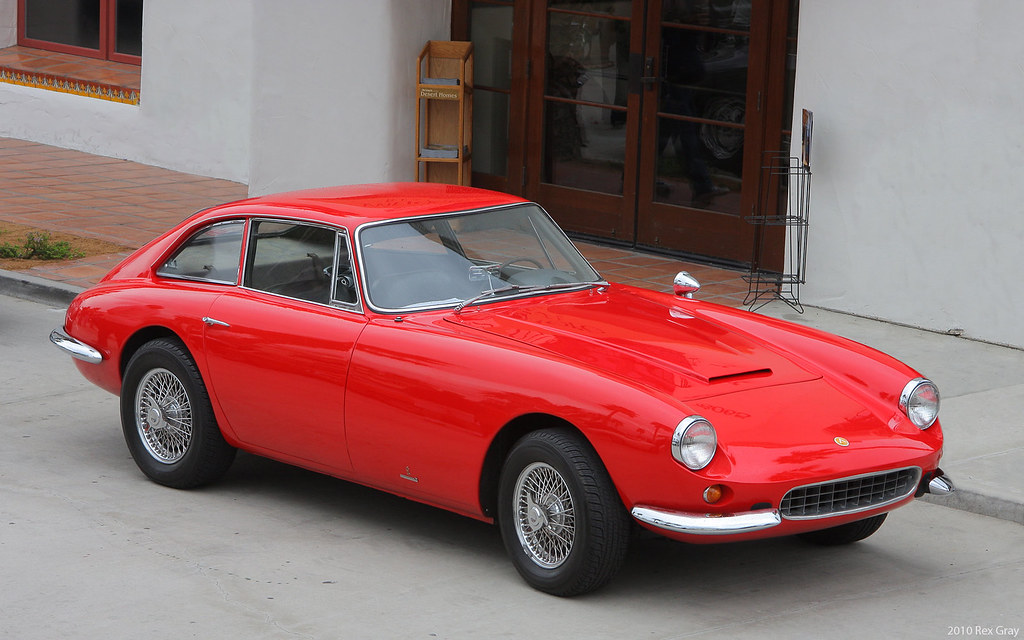
12. **Apollo 5000 GT: America’s Answer to Ferrari** What do you get when you combine American reliability with the undeniable artistry of Italian craftsmanship? You get Milt Brown’s vision: the Apollo 5000 GT, America’s bold answer to the European grand touring elite. Born from a collaboration with Frank Reisner’s Intermeccanica facilities, the Apollo was a stunning blend of two automotive cultures. Scaglione’s design refinements gifted it timeless proportions and Italian coachbuilding excellence, creating an exotic appearance that could genuinely compete, visually and dynamically, with contemporary Ferrari alternatives.
Beneath that exquisite Italian skin lay a heart of pure American muscle: a robust 4.9L Buick V8 engine, delivering a healthy 250 horsepower. This reliable powerplant was mated to a crisp four-speed manual transmission, providing a truly engaging driving experience. The power was channeled through a sturdy ladder-frame chassis that cleverly incorporated Buick suspension components, ensuring a blend of comfortable touring and spirited handling that belied its cross-continental heritage.
Step inside, and the Apollo’s luxurious appointments more than justified its premium market positioning. The cabin was a showcase of thoughtful design, featuring comprehensive instrumentation that included both a tachometer and a 180-mph speedometer, hinting at its serious performance capabilities. Comfortable seating provided ample touring comfort without sacrificing that all-important sporting character, making it a true GT in every sense of the word.
Sadly, only 88 total Apollos were produced before financial constraints eventually ended production, making each surviving example a coveted piece of automotive history. This scarcity, combined with its unique blend of American power and Italian elegance, has ensured its status as an undervalued gem for far too long. However, collectors are waking up: current market values around $150,000 represent significant appreciation potential compared to similar, often more lauded, European exotics. It’s a testament to a vision that, though cut short, left an indelible mark.
Car Model Information: 2020 Hyundai PALISADE Limited
Name: Apollo
Caption: 1965 Apollo 5000 GT Coupe
Manufacturer: International Motor Cars
Aka: Vetta Ventura
Production: 1962 – 1964,88 produced
ModelYears: 1962 – 1965
Assembly: Oakland, California
Class: Sports car
BodyStyle: Fastback
Engine: {{convert,215,CID,L,1,abbr=on,Buick V8 engine#215
Abbr: Buick V8 engine#300
Transmission: manual transmission
Wheelbase: Convert
Url: http://www.automobile-catalog.com/make/apollo/apollo_gt/apollo_gt_convertible/1963.html
Title: 1963 Apollo GT Convertible performance data, specs & photo
Publisher: Automobile-catalog.com
Accessdate: 2011-11-20
Length: Convert
Width: Convert
Height: Convert
Weight: Convert
Designer: Franco Scaglione
Sp: us
Categories: Articles with short description, Cars of the United States, Defunct motor vehicle manufacturers of the United States, Motor vehicle manufacturers based in California, Short description is different from Wikidata
Summary: The Apollo GT is an Italian-American sports car, initially marketed from 1962 to 1964 by International Motor Cars in Oakland, California.
Engineered by Milt Brown and designed by Ron Plescia, it featured handmade Italian bodywork and chassis by Intermeccanica, with a choice between two-seater convertible or fastback styles. Power came from a 215 cu in (3.5 L) or 300 cu in (4.9 L) Buick engine mated to a 4-speed manual.
The initial company completed assembly of 42 cars before suspending production while seeking new financing. IMC allowed the sale of Intermeccanica body/chassis units to Vanguard Motors in Dallas, Texas, to produce cars under the Vetta Ventura name. These were made until 1966 as a stop-gap measure to keep body producer Intermeccanica in business until new backers were found. Other production arrangements followed, assembling cars not completed by International.
A total of 88 cars have been produced to date by all entities.
Get more information about: Apollo GT
Buying a high-performing used car >>>
Brand: Apollo Model: 5000 GT
Price: $24,987 Mileage: 84,683 mi.
13. **Byers SR100: America’s Homegrown Supercar** Back in the freewheeling 1950s California, a true pioneer named Jim Byers was busy laying the groundwork for America’s homegrown supercar scene. Building on his earlier Meteor SR1 experience, Byers pioneered fiberglass sports car construction, creating the SR100. This wasn’t some cookie-cutter assembly line job; it was hand-laid fiberglass construction, demonstrating advanced materials application and a dedication to pushing boundaries. Its low-slung proportions, emphasizing performance aesthetics, made it an absolute head-turner.
What truly set the SR100 apart were its distinctly American muscle car proportions, which boldly distinguished it from its more lithe European alternatives. This car had a swagger, a confident stance that radiated power. Most examples were fitted with potent 265 cubic inch V8 engines, churning out a respectable 195 horsepower and a solid 260 lb-ft of torque. This was an American beast with a custom-built body, a fusion of power and bespoke design.
The interior wasn’t about lavish luxury; it was about functional layouts that prioritized driving dynamics above all else. Racing-derived seating positions placed drivers within optimal control reach, ensuring a direct and uncompromised connection to the road. Instrumentation provided essential performance data without any unnecessary complexity, a clear indication that this car was built for serious driving.
With approximately only 50 total cars produced, the Byers SR100 is a rare bird, a true collector’s item that offers a unique category for hand-built American fiberglass sports cars. And here’s a cool bonus: despite its exotic origins, parts availability through Chevrolet networks makes ownership surprisingly practical. It’s a fantastic example of American ingenuity, proving that you don’t need an overseas badge to create something truly special and profoundly underrated.
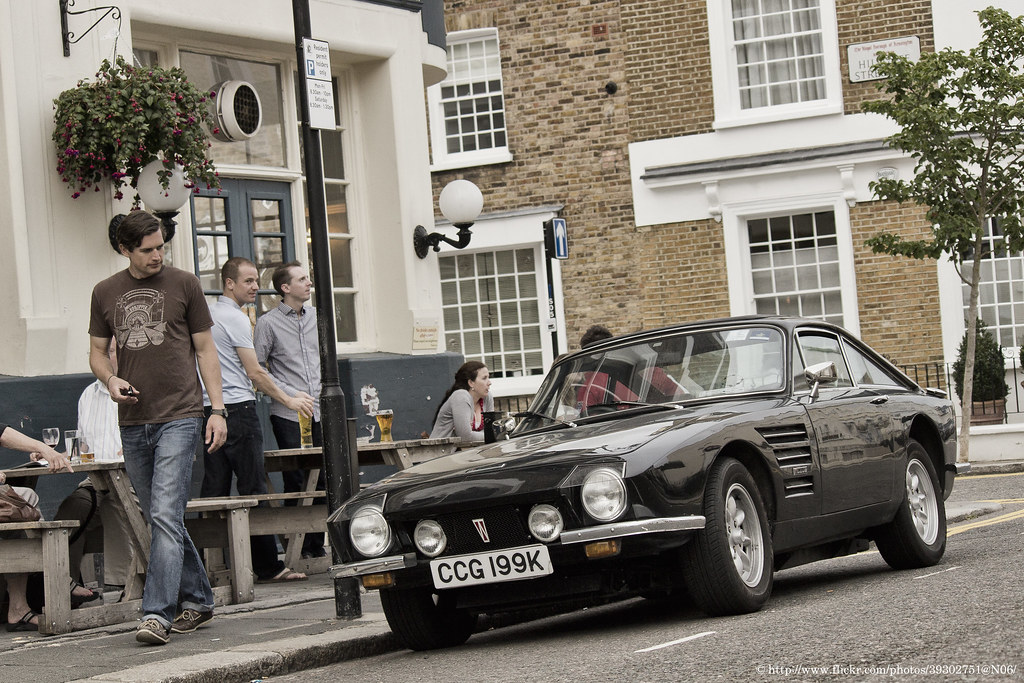
14. **Trident Venturer: The British GT You Never Knew Existed** Ah, the late 1960s – a time of innovation, experimentation, and some truly fascinating automotive concoctions. Enter Trident Cars, who combined a stretched Triumph TR6 chassis with the bulletproof reliability of a Ford Essex V6 to create the Venturer. This was a clever bit of kit, marrying British sports car handling with readily available, dependable power. And in a stroke of genius, its sophisticated fiberglass proportions not only looked fantastic but also eliminated those dreaded rust concerns that plagued so many of its metal-bodied contemporaries.
The Venturer’s design was pure purpose. Distinctive side vents and a steeply raked rear deck conveyed purposeful aesthetics, giving it a sleek, aerodynamic profile that was both aggressive and elegant. The 3.0L Essex V6 delivered a healthy 140 horsepower through a smooth four-speed manual transmission, complemented by independent suspension and disc brakes. This wasn’t a fire-breathing monster, but a refined GT, built for eating up miles with grace and enthusiasm.
Inside, the luxurious appointments more than justified its premium pricing strategies. Back in 1971, its original retail price of $2,875 plus a $720 purchase tax was significant money, requiring careful consideration from buyers. But they got their money’s worth: walnut dashboard veneers complemented leather-trimmed steering wheels, and comprehensive instrumentation provided drivers with complete vehicle information. And for a GT, it offered substantial luggage space, though boot access required interior entry – a charmingly quirky British touch that just adds to its character.
Today, the Venturer remains an exceptionally rare sight, with the Trident Car Club tracking around 55 examples, and only 19-25 currently roadworthy. This scarcity, combined with the practical benefit of readily available Ford parts, makes Venturers an increasingly attractive, and surprisingly practical, collector proposition. They’re finally stepping out of the shadows, proving that sometimes the best British GTs are the ones you never even knew existed, but now desperately want.
***
And there you have it, folks! We’ve journeyed through the nooks and crannies of automotive history, bypassing the usual superstars to shine a light on the true unsung heroes. These cars, from the micro-innovators to the V12 sledgehammers, the forgotten prototypes to the cross-continental hybrids, all possessed a unique spark of genius. They were often ahead of their time, misunderstood by the masses, or simply overshadowed by flashier siblings. But for those of us with oil in our veins and a keen eye for genuine automotive brilliance, these machines are more than just old metal; they’re testaments to passion, engineering daring, and distinctive character. So, the next time you’re dreaming of your ultimate garage, don’t just look at the usual suspects. Dig a little deeper. You might just find your next obsession in one of these magnificently overlooked rides. Your loss, mainstream buyer, our gain!

